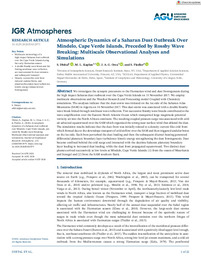Por favor, use este identificador para citar o enlazar este ítem:
https://hdl.handle.net/11000/35189Registro completo de metadatos
| Campo DC | Valor | Lengua/Idioma |
|---|---|---|
| dc.contributor.author | Dhital, Saroj | - |
| dc.contributor.author | Kaplan, Michael L. | - |
| dc.contributor.author | Garcia Orza, Jose Antonio | - |
| dc.contributor.author | Fiedler, Stephanie | - |
| dc.contributor.other | Departamentos de la UMH::Física Aplicada | es_ES |
| dc.date.accessioned | 2025-01-23T20:15:01Z | - |
| dc.date.available | 2025-01-23T20:15:01Z | - |
| dc.date.created | 2020 | - |
| dc.identifier.citation | Journal of Geophysical Research: Atmospheres | es_ES |
| dc.identifier.issn | 2169-8996 | - |
| dc.identifier.issn | 2169-897X | - |
| dc.identifier.uri | https://hdl.handle.net/11000/35189 | - |
| dc.description.abstract | We investigate the synoptic precursors to the Harmattan wind and dust frontogenesis during the high impact Saharan dust outbreak over the Cape Verde Islands on 13 November 2017. We employ multiscale observations and the Weather Research and Forecasting model Coupled with Chemistry simulations. The analyses indicate that the dust storm was initiated on the lee side of the Saharan Atlas Mountains (SAM) in Algeria on 10 November 2017. This dust storm was associated with a double Rossby wave break linked through nonlinear wave reflection. Two successive Rossby wave breaks contributed to the wave amplification over the Eastern North Atlantic Ocean which transported large magnitude potential vorticity air into the North African continent. The resulting coupled pressure surge was associated with cold air advected equatorward over the SAM which organized the strong near-surface wind that ablated the dust. The simulation results indicate that the dust front was initially related to a density current-like cold front which formed due to the downslope transport of cold airflow over the SAM and then triggered undular bores on the lee side. Each bore perturbed the dust loading and then the subsequent diurnal heating generated differential planetary boundary layer turbulence kinetic energy strengthening the dust frontogenesis. Dust became confined behind the cold surge and interacted with the daytime Saharan planetary boundary layer leading to increased dust loading, while the dust front propagated equatorward. Two distinct dust plumes arrived successively at low levels at Mindelo, Cape Verde Islands: (1) from the coasts of Mauritania and Senegal and (2) from the SAM southern flank. | es_ES |
| dc.format | application/pdf | es_ES |
| dc.format.extent | 22 | es_ES |
| dc.language.iso | eng | es_ES |
| dc.publisher | American Geophysical Union. Wiley | es_ES |
| dc.relation.ispartofseries | 125 | es_ES |
| dc.relation.ispartofseries | 18 | es_ES |
| dc.rights | info:eu-repo/semantics/openAccess | es_ES |
| dc.rights | Attribution-NonCommercial-NoDerivatives 4.0 Internacional | * |
| dc.rights.uri | http://creativecommons.org/licenses/by-nc-nd/4.0/ | * |
| dc.subject.other | CDU::5 - Ciencias puras y naturales::53 - Física | es_ES |
| dc.title | Atmospheric Dynamics of a Saharan Dust Outbreak Over Mindelo, Cape Verde Islands, Preceded by Rossby Wave Breaking: Multiscale Observational Analyses and Simulations | es_ES |
| dc.type | info:eu-repo/semantics/article | es_ES |
| dc.relation.publisherversion | https://doi.org/10.1029/2020JD032975 | es_ES |

Ver/Abrir:
FreeAccess-Q2-2020-Dhital-Atmospheric Dynamics of a Saharan Dust Outbreak Over Mindelo-6.pdf
88,67 MB
Adobe PDF
Compartir:
 La licencia se describe como: Atribución-NonComercial-NoDerivada 4.0 Internacional.
La licencia se describe como: Atribución-NonComercial-NoDerivada 4.0 Internacional.
.png)